European shares rebounded on Monday, perhaps as ECB President Lagarde pushed against expectations over a July hike by the ECB. Still, Wall Street continued to slide, as Friday’s better-than-expected US jobs data encouraged market participants to add to bets over faster tightening by the Fed.
With the calendar staying light today and tomorrow as well, market participants may be sitting on their hands in anticipation of the US CPI for January, due out on Thursday.
EU Shares Gain, Wall Street Slides Amid Light Economic Agenda
The US dollar traded mixed against the other major currencies on Monday and during the Asian session Tuesday. It gained only versus EUR and JPY, while it underperformed against AUD, CAD and NZD in that order. The greenback was found virtually unchanged versus GBP and CHF.

The weakening of the Japanese yen and the strengthening of the commodity-linked Aussie, Loonie and Kiwi suggest that markets may have traded in a risk-on fashion yesterday and today in Asia.
Turning our gaze to the equity world, we see that, indeed, most major EU indices traded in the green, but during the US session, appetite softened.
Both the S&P 500 and the NASDAQ slid, while the Dow Jones Industrial Average finished virtually unchanged. Sentiment improved again today in Asia, with only Hong Kong’s Hang Seng losing ground. All other indices under our radar traded in the green.

European shares rebounded, perhaps due to remarks by ECB President Christine Lagarde, who pushed against expectations over a July rate hike by the ECB. Specifically, the ECB Chief said no signs that measurable monetary policy tightening would be required.
Yes, last week, she opened the door for a rate increase later this year, but maybe this could happen during the last quarter, a view expressed by ECB member Klaas Knot.
Having said all that, Wall Street investors may have continued reducing their risk exposures, perhaps after Friday’s better-than-expected employment data. Although this adds more credence to the strong performance of the US economy, combined with accelerating wages, it encourages market participants to add to their bets over faster tightening by the Fed.
According to the Fed funds futures, investors anticipate five quarter-point rate increases by the end of this year, and accelerating inflation on Thursday could prompt them to add more. Something like that could support the US dollar and result in another setback in risky assets.
EUR/USD – Technical Outlook
EUR/USD traded lower on Monday after hitting resistance at 1.1483 on Friday. At the time of writing, the rate is testing Friday’s low of 1.1413, but it still stays above the key zone of 1.1375, which acted as the upper bound of the range that continued the price action between Nov. 26 and Jan. 12. Thus, we would still see chances of a potential rebound.
Even if the slide continues below 1.1413, as we already noted, the bulls could take charge from near the 1.1375 barrier, resulting in a rebound and another test at the 1.1483 zone, which was tested, not only on Friday but on Jan. 13 and 14 as well. If the buyers are unwilling to stop there this time around, we could see them pushing towards the 1.1524 zone, marked by the inside swing lows of Oct. 12 and Nov. 4, respectively.
Now, to abandon the bullish case, we would like to see a dip back below 1.1335. This may confirm the rate’s return within neutral waters and could initially allow declines towards the 1.1280 territory, near which the pair rebounded last week after the ECB decision. If that zone fails to provide support this time around, we may see the fall extending towards the 1.1234 area, which was the lower end of the aforementioned range.

AUD/JPY – Technical View
AUD/JPY edged north today during the Asian session, breaking above the downside resistance line drawn from the high of Jan. 5, as well as above the key barrier of 82.20. This, combined with the fact that the rate is now trading above a newly-established upside line drawn from the low of Jan. 28, paints a positive short-term picture.
In our view, the break above 82.20 may have opened the way for advances towards the 83.00 area, near the peaks of Jan. 18 and 20. If the bulls are unwilling to stop there, we may see them climbing towards the 83.36 or 83.75 zone, defined as resistances by the highs of Jan. 10 and 13, respectively.
The outlook could turn negative again upon a dip below the 81.30 zone, marked by the low of Feb. 4. The rate will be back below the aforementioned diagonal lines, and it will also confirm a forthcoming lower low on the 4-hour chart. The bears could then get encouraged to push the action to the 80.90 barrier, marked by the low of Feb. 1, or the 80.35 zone, marked by the low of Jan. 28. If they don’t stop there either, we may see them driving towards the low of Dec. 6, at 79.85.

Elsewhere
We have the US NFIB small business optimism index for January and Canada’s trade balance for December. No forecast is available for the NFIB index, while Canada’s trade surplus is expected to have decreased to CAD 2.62bn from CAD 3.13bn.
